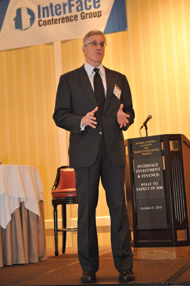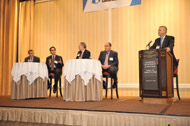|
COVER STORY, DECEMBER 2010
WHAT TO EXPECT IN 2011
A conference summary from InterFace Investment & Finance.
Amy Bigley, Jaime Lackey and Coleman Wood
France Publications recently joined forces with Morris, Manning & Martin to hold InterFace Investment & Finance: What to Expect in 2011. Held in Atlanta, the conference offered expert insight on the future of the investment and finance markets throughout 2011.
Keynote Address
 |
Keynote Speaker Dr. Peter Linneman addresses conference attendees at InterFace Investment and Finance: What to Expect in 2011, which was sponsored by Morris, Manning & Martin and France Publications.
|
|
“The real estate industry isn’t going to disappear — some people and concepts may — but the real estate industry isn’t going to disappear, there is a morning after,” said Peter Linneman, principal of Linneman Associates and professor at the Wharton School of Business, University of Pennsylvania.
Linneman’s keynote address highlighted and expounded upon many of the issues facing the current economy, particularly as it relates to commercial real estate investments and financing. Linneman noted that one of the United States’ main mistakes in the recession was panicking and throwing out the rules, which kept our economy in check, “The U.S. became a third-world country when we gave up our greatest strength, which is the predictability of rules.”
The loss of rules and predictability results in a stalled economy, the loss of jobs and a loss of perspective for future investments and dealings. But all is not lost for the country’s economy. Even in a mediocre year the United States is still generating a $420 billion GDP, which compares favorably to China’s $440 billion GDP that the country brought in during a great year.
As the economic and political players recognize that the United States is still a strong and profitable economy, Linneman believes that the resulting gridlock, especially politically, will cause the change and enforcement of rules needed to bring the much needed predictability back to the country’s economy.
Debt — Has the Debt Market Stabilized and is Liquidity Back?
 |
Panelists (left to right) Robert Kalinowski, Jonathan Rice, Jeffrey Warwick and Peter Scola, along with Moderator Wes Boatwright, discuss the debt market in “Debt - Has the Debt Market Stabilized and is Liquidity Back?” panel at the conference.
|
|
Moderator Wes Boatwright, managing director with Jones Lang LaSalle, led a panel discussion about the country’s debt market and where it is in the recovery phrase. Panelists were Robert Kalinowski, U.S. East Coast portfolio manager with Allstate Investment; Jonathan Rice, CBRE Capital Markets Group with W.P. Carey & Co.; Peter Scola, senior managing director with Cantor Commercial Real Estate; and Jeffrey Warwick, market executive with Bank of America Merrill Lynch.
“The debt market definitely has much more liquidity than it has in the past 2 to 3 years. You’ll see a lot more happier faces in brokers office, owners and some lenders,” said Scola.
Companies are beginning to put more money in lending although caution still prevails in most cases. The market is experiencing a flight to quality, whether in property class or location, which makes the ideal deals extremely competitive and mediocre deals more difficult to finance.
For now, the capital and debt markets are emerging from the recession with a positive future, albeit it slow moving, until predictability and stabilization are permanent fixtures on the market.
— Amy Bigley
Panel: Equity Capital
The recession has been frustrating for investors looking for opportunity. “Eighteen months ago, there was a lot of uncertainty. Class A assets were trading in the mid-7s. It was the buyer opportunity of a century — and it didn’t matter because there was no product,” said Robert LaChapelle of CBRE Capital Markets Group.
According to Dean Adler of Lubert-Adler Group, equity may find the strongest advantage by partnering directly with borrowers in need of capital. Being invited to the discussion between borrowers and lenders ensures more current information about the asset. A three-way deal between borrower, lender and new capital gives the new capital some control over the asset and avoids the loan auction scenario, where the risk premium can be lost.
Panel: The Outlook for Core Investment in 2011
Stable core products are in the greatest demand while the sellers and buyers are having trouble agreeing on prices for opportunistic and value-add deals, noted Chris Marshall of Jones Lang LaSalle.
Panel: Still Pretending/Extending or Ready to Dispose?
The general consensus was that ‘pretend and extend’ is working for the banks. However REO volume is starting to increase, especially as lenders see values increasing.
“Arguably, there is $2 billion of capital [represented] in this room today to invest in distressed assets,” said Ron Glass of GlassRatner Advisory & Capital Group. “There is great opportunity for companies that can figure out how to connect the dots.”
2011 will be a year where a lot of things get worked out but there will also be a lot of defaults, especially in C properties, Glass said. “Larger properties will get moved out, recast and improved and that will be good for the market”.
John Charles of Trimont Real Estate Advisors noted that much will depend on the underwriting in 2011.
Panel: Distressed Investment
According to Donald Sheets of Square Mile Capital the greatest opportunity in the distressed arena is for companies that have the ability to underwrite and workout small pools of loans. “People thought it would be RTC 2.0. I think it is SS 1.0 — special servicer 1.0,” he said.
Companies that can’t transact in the FDIC environment today can embark on the path of special servicers and stay busy, Sheets noted. “We see billions more paper coming off special servicers in 2011. The paper that is transacting today is collateral that defaulted in 2008. All the 2009 as well as the rolling 2010 defaults are not coming to market yet because they are still in the forbearance and in the early stage of the workout process.”
— Jaime Lackey
Panel: Development – When is Development Coming Back and How to be in First-Mover Position?
The final session of the day focused on development, something few people are seeing right now and most wish would return in a hurry.
“Aside from multifamily, there is very little new development going on,” said Tom Senkbeil, managing director of the Southeast and Mid-Atlantic regions for Sealy & Co.
The panelists said there is almost no speculative development occurring right now. The industrial sector is weak in all but a few select markets, as is the retail sector, and the office sector is doing even worse. In fact, Tom Roberts, president of the real estate group for Cole Real Estate, said he thinks it will be 8 to 10 years before the office sector starts seeing new speculative projects.
The panel discussed sustainability, and mentioned that with the lack of new construction, a lot of green construction is focusing on retrofitting existing buildings for sustainability. This is in response to clients who are demanding green projects and from consumers themselves.
“Sustainability is a given,” said Larry Gellersted, president and CEO of Cousins Properties. “It’s a value set this [younger] generation has at its core.”
Looking to the near term future, there was consensus that things would start to pick up in 2011, but 2012 would be better. In the meantime, much of the new buildings that come out of the ground will be build-to-suit projects.
— Coleman Wood
©2010 France Publications, Inc. Duplication
or reproduction of this article not permitted without authorization
from France Publications, Inc. For information on reprints
of this article contact Barbara
Sherer at (630) 554-6054.
|
